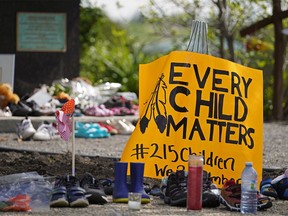
…
One of 2021’s biggest stories was the “discovery” of unmarked children’s graves in the grounds of Kamloops, B.C.’s, former industrial residential school (1890-1978), founded by Shuswap Chief Louis Clexlixqen, and run by the Missionary Oblates of Mary Immaculate and the Sisters of St. Anne of Quebec.
The “discovery” meme arose from a scanning by ground-penetrating radar in a search for the remains of children already surmised to have been buried there. A preliminary report did not find bodies, but rather soil disruptions in a nearby apple orchard. No remains were exhumed, but First Nation Chief Rosanne Casimir stated that according to community “knowledge,” the soil abnormalities were 215 “missing children,” some as young as three.
The anthropologist who oversaw the scans cautiously theorized that there were likely 200 “probable burials” — not specifying age — based on the disturbances. But only excavation could provide further evidence of anything, and no excavation has yet been done. But the story was too good to fact-check, and went viral, often with the trope “mass graves” substituting for “unmarked graves,” a distinction with an enormous difference, since “mass” graves are associated with genocide.
Suddenly there was talk of “thousands” of “missing” Indigenous children whose parents had not been informed of their deaths. The Parliamentary flag was lowered to half-mast; China (of all nations) called for an investigation into Canada’s human rights violations at the UN Human Rights Tribunal; Pope Francis expressed pain over the “shocking discovery in Canada of the remains of 215 children” at Kamloops.
Nobody in political authority — certainly not our instantly and abjectly apologetic prime minister — has to date pointed out that no actual remains have been found. Thus, Rouillard writes, “[G]overnments and the media are simply granting credence to what is really a thesis: the thesis of the ‘disappearance’ of children from residential schools.” The consensus of “cultural genocide,” endorsed by the TRC (but contested by many accredited historians routinely cold-shouldered by uncritical mainstream media), has effectively been elevated to literal genocide, “a conclusion that the Commission explicitly rejects in its [TRC] report.”
